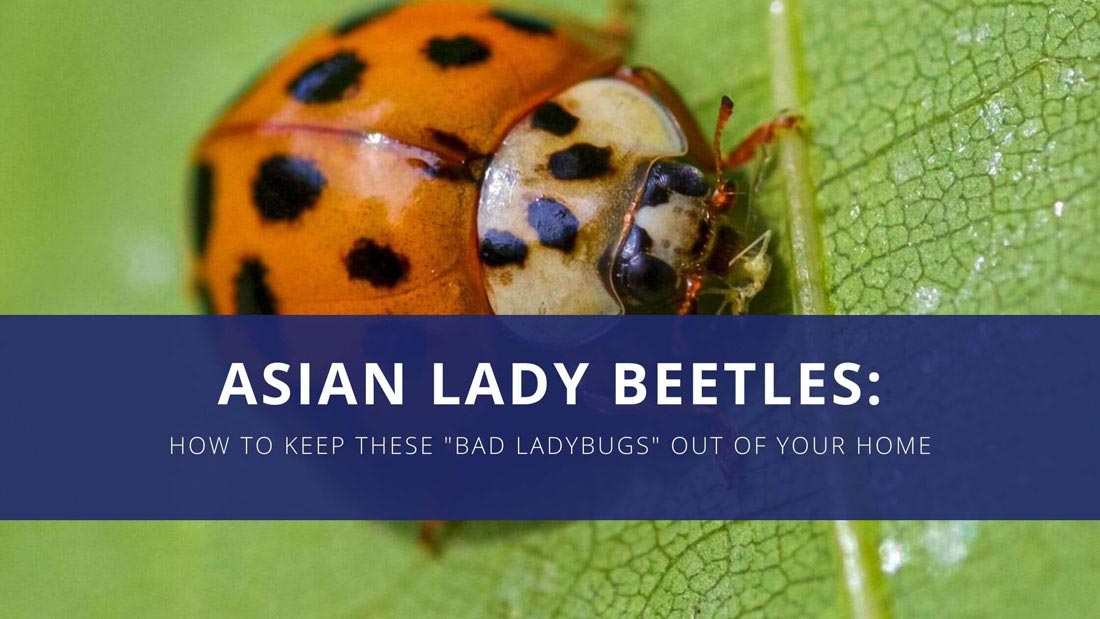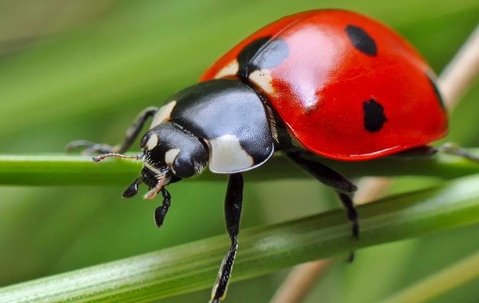Vacuuming and sealing entry points are effective methods for ladybug removal. Proper home maintenance keeps ladybugs at bay.
Ladybugs, often considered beneficial insects, can become pests when they invade homes in large numbers. They seek shelter indoors during colder months, causing inconvenience. Simple yet effective methods, such as vacuuming and sealing entry points, can help manage these infestations.
Regularly inspecting and maintaining your home’s exterior reduces the chances of ladybug invasions. Keeping your living space tidy and well-sealed ensures that ladybugs and other pests stay outside. Implementing these strategies provides a straightforward solution to maintaining a bug-free home environment.
Identifying Ladybug Infestations
Spotting a ladybug or two might seem harmless, but large numbers can become a problem. Identifying a ladybug infestation early can help you take action quickly. Learn to recognize the signs and types of ladybugs to manage these pests effectively.
Signs Of Infestation
Ladybugs often gather in groups. If you see clusters of ladybugs in your home, it’s a sign of infestation. Look for these signs:
- Small, red or orange beetles with black spots on windowsills and walls.
- Yellowish stains on walls or furniture from ladybug secretions.
- Increased presence of ladybugs in the fall as they seek shelter from the cold.
Inspect the cracks and crevices in your home. Ladybugs can squeeze through tiny openings to enter.
Types Of Ladybugs
Understanding the types of ladybugs can help you identify and control them better. Here are some common types:
| Type of Ladybug | Description |
|---|---|
| Asian Lady Beetle | Often mistaken for native ladybugs; they have a distinctive “M” shape on their back. |
| Seven-Spotted Ladybug | Native to Europe, they have seven black spots on their red wings. |
| Convergent Ladybug | Common in North America, they have two white lines that converge behind their heads. |
Asian Lady Beetles are the most common invaders in homes. They can bite and secrete a foul-smelling liquid. Seven-Spotted Ladybugs and Convergent Ladybugs are generally harmless and beneficial for gardens.

Credit: www.wil-kil.com
Prevention Tips
Ladybugs can be cute, but they can also be pests. Keeping them out of your home is important. Here are some prevention tips to help you keep ladybugs away.
Sealing Entry Points
Ladybugs often enter homes through small cracks and gaps. To prevent this:
- Inspect windows and doors for gaps.
- Use caulk to seal cracks around windows and doors.
- Check for gaps around pipes and cables.
- Install door sweeps to block entry points.
By sealing these entry points, you can keep ladybugs out.
Using Natural Repellents
Natural repellents can deter ladybugs from entering your home. Here are some effective options:
- Bay leaves: Place bay leaves on windowsills and near entry points.
- Cloves: Sprinkle cloves around areas where ladybugs enter.
- Essential oils: Use lemon or peppermint oil to repel ladybugs.
These natural methods are safe and effective.
By following these prevention tips, you can enjoy a ladybug-free home.
Natural Removal Methods
Are pesky ladybugs invading your home? You can remove them naturally. The use of natural methods ensures a safe and non-toxic environment. Here are some effective ways to say bye-bye to ladybugs.
Essential Oils
Essential oils are a great natural remedy. Ladybugs dislike certain scents. Use peppermint oil, tea tree oil, or lavender oil. Follow these steps:
- Add 10 drops of essential oil to a spray bottle.
- Fill the bottle with water and shake well.
- Spray the mixture around windows and doors.
- Repeat this daily for best results.
This method is safe for pets and kids. Plus, your home will smell wonderful!
Homemade Traps
You can also use homemade traps to catch ladybugs. They are easy to make and effective. Follow these steps to create a simple trap:
- Take an empty plastic bottle.
- Cut the top part off and inve
Chemical Solutions
Ladybugs can be a nuisance when they invade your home. Sometimes, chemical solutions are the best way to get rid of them. These methods can be effective when used correctly. Let’s explore some safe options and understand when to use chemicals.
Safe Pesticides
Using safe pesticides is crucial to protect your family and pets. Many products are available that target ladybugs specifically.
- Look for pesticides labeled for indoor use.
- Choose products with low toxicity to humans and animals.
- Consider organic or natural options.
Here is a table of some safe pesticides:
| Product Name | Toxicity Level | Target Insects |
|---|---|---|
| Eco Defense | Low | Ladybugs, Ants |
| Wondercide | Low | Ladybugs, Fleas |
| MDX Concepts | Low | Ladybugs, Spiders |
When To Use Chemicals
Chemicals should be used carefully. They are effective in severe infestations.
- Identify the type of ladybug.
- Assess the infestation level.
- Use chemicals if other methods fail.
Always read the instructions on pesticide labels. Follow safety guidelines to avoid harm. Keep pesticides out of reach of children and pets.
Using chemicals can solve your ladybug problem quickly. Ensure you choose safe options for your home.
Professional Help
Dealing with ladybug infestations can be overwhelming. Sometimes, professional help is necessary. Professional exterminators have the expertise and tools to handle large infestations. This section will guide you on when to call an exterminator and what to expect during the process.
When To Call An Exterminator
- If you notice a large number of ladybugs in your home.
- When DIY methods fail to remove the infestation.
- If ladybugs are causing damage or spreading allergens.
- When you want a quick and effective solution.
What To Expect
Professional exterminators follow a structured process to remove ladybugs. Knowing what to expect can make the experience smooth:
| Step | Description |
|---|---|
| Inspection | Exterminators inspect your home to assess the infestation level. |
| Plan | They create a tailored plan to address the specific issue. |
| Treatment | Professionals use safe and effective methods to remove ladybugs. |
| Prevention | They offer tips to prevent future infestations. |
Hiring a professional ensures effective and long-lasting results. It saves you time and effort, giving you peace of mind.
Long-term Strategies
Long-term strategies are crucial to keep ladybugs away for good. These methods ensure your home remains ladybug-free year-round. This section covers essential tactics to maintain a ladybug-free environment.
Maintaining A Ladybug-free Home
To maintain a ladybug-free home, practice regular cleaning. Vacuum frequently to remove any lingering bugs. Seal all cracks and crevices in walls and windows. Ensure screens on doors and windows are intact. Consider using natural repellents like bay leaves or clove oil. These methods create an uninviting environment for ladybugs.
Seasonal Precautions
Ladybugs often seek shelter during colder months. Take seasonal precautions to prevent infestations. In spring and summer, check for entry points and seal them. In fall, inspect your home for any gaps or cracks. Add weather stripping to doors and windows. Keep outdoor lights off at night to avoid attracting ladybugs. Store firewood away from your home, as it can harbor insects.
| Season | Precautions |
|---|---|
| Spring | Check for entry points and seal them. |
| Summer | Keep outdoor lights off at night. |
| Fall | Inspect for gaps and add weather stripping. |
| Winter | Store firewood away from home. |
Following these steps ensures a ladybug-free home throughout the year. Consistent effort and attention to detail will keep these pests at bay.
Myths Vs. Facts
There are many myths about ladybugs. Some say they bring good luck. Others believe they harm plants. This section will clear up these myths and share some facts.
Ladybugs And Luck
Many people think ladybugs bring good luck. This is a common myth. Some cultures believe ladybugs bring love or money. But this is not true.
Ladybugs are helpful insects. They eat pests like aphids. This makes them good for gardens. But they do not bring luck or money. They are just helpful bugs.
Environmental Impact
Ladybugs are good for the environment. They help control pests in gardens. This means fewer chemicals are needed. This is good for the earth.
But too many ladybugs can be a problem. They can invade homes. This is not good for people. It is important to control ladybug numbers.
| Myth | Fact |
|---|---|
| Ladybugs bring good luck | Ladybugs help control pests |
| Ladybugs harm plants | Ladybugs eat harmful pests |
It is important to know the truth about ladybugs. They help the environment. But too many can be a problem. Understanding these facts can help manage them better.

Credit: www.amazon.com

Credit: www.go-forth.com
Frequently Asked Questions
How Do I Remove Ladybugs From My Home?
To remove ladybugs, use a vacuum cleaner to collect them. Seal entry points with caulk to prevent re-entry. Consider using natural repellents like citrus or bay leaves.
What Attracts Ladybugs To My House?
Ladybugs are attracted to warm environments and light-colored homes. They often seek shelter during colder months. Food sources like aphids in gardens can also attract them.
Are Ladybugs Harmful To Humans Or Pets?
Ladybugs are generally harmless to humans and pets. They do not carry diseases. However, some species can bite, causing minor irritation.
Can I Prevent Ladybugs From Entering My House?
Seal cracks and gaps in windows and doors. Use weather stripping and screens. Regularly inspect and maintain your home to keep ladybugs out.
Conclusion
Effective ladybug removal is achievable with the right methods. Use natural remedies and keep your home sealed. Professional pest control can also be a viable option. Implement these strategies to enjoy a ladybug-free environment. Remember, consistent efforts will ensure lasting results.
Say goodbye to ladybugs and welcome a pest-free home.


